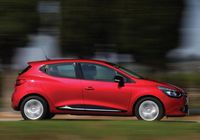Renault-Engined Title-Winning Formula One And Road Cars 'Are Family'
LONDON – Oct 15, 2013: Some of the same technology powering Formula One ace Sebastian Vettel potentially towards his fourth straight FIA Formula One World Championship also appears in Renault’s road cars and vans. As the French marque’s latest promotion will highlight in the coming weeks.
On the back of a fully Renault-engined podium at the weekend at the Japanese Grand Prix and as the season reaches its climax, the brand’s ‘We are family’ campaign highlights the strong connections between circuit and street.
German driver Vettel has already driven one such F1-inspired model in the Renault range, the Twizy Renaultsport F1. The eye-catching, two-seat electric compact has been utterly transformed, so that among its race car similarities are motorsport-derived elements such as a front splitter, rear wing, F1-style rain light, and its most crucial inclusion, its own Kinetic Energy Recovery System (KERS). This temporarily boosts its power instantly almost six-fold from 17hp to a heady 97hp, catapulting it from standstill to 62 mph as swiftly as Renault’s fastest current model, Mégane Renaultsport 265.
The national ‘We are family’ promotion includes radio and print advertising which will build up towards Formula One race weekends, with the offer of having a New Clio from £129 per month with one year’s free insurance, or a van from just £169.99 per month. Renault will also be ‘taking over’ the Sky Sports homepage for the Abu Dhabi and Brazilian Grand Prix in November and will feature on the dedicated F1 Channel.
Renault has been using its racing know-how to develop fuel-efficient engines for road cars for many years, and this is most apparent in its Energy range.
The Energy TCe family marks a fresh development in Renault's petrol engine strategy and is expected to account for 85 per cent of the brand's petrol engine sales in Europe by 2015. In TCe 115 form, its 1.2-litre engine gives unprecedented performance and fuel efficiency. It was designed to maximise driving pleasure and acceleration with downsized engines that lower fuel consumption and CO2 emissions. Its diesels are also class-leading. In several models, the 1.5-litre dCi 90 sits easily under the 100g/km VED band, meaning there’s no road tax in either the first year, or currently, beyond. In Clio it also gives combined fuel economy of up to 88.3 mpg in the combined cycle.
The company has employed these very same principles to developing the F1 Power Unit 2014 to be used in racing next year by Red Bull Racing, Scuderia Toro Rosso and Caterham F1. Creating a complete, and genuine, circular development process between road and track and clearly illustrating that the F1 Power Unit shares the same DNA as its road-going cousins.
Jean-Michel Jalinier, President of Renaultsport F1, said ahead of the sport’s major shake-up: “From next year, one of greatest challenges in F1 will be to maximise energy efficiency and fuel economy while maintaining the power output and performance expected of F1 cars. Renault has pioneered this technology in its road car engine range with the Energy series. Naming the Power Unit Energy F1 creates an unbroken range, from the New Clio through to our competition department.”
In 2014, Formula 1 will enter a new era. After three years of planning and development, the most significant technical change to hit the sport in more than two decades is introduced. Engine regulations form the major part of the coming revolution, with the introduction of a new generation of Power Units that combine a 1.6-litre V6 turbocharged engine with energy recovery systems that will dramatically increase efficiency by harvesting energy dissipated as heat in the exhaust or brakes.
The maximum power of the new Power Unit will exceed the output of current V8 F1 engines, however, fuel efficiency will be radically improved. With only 100kg permitted for the race, the new units will use an incredible 35% less fuel than their predecessors.



